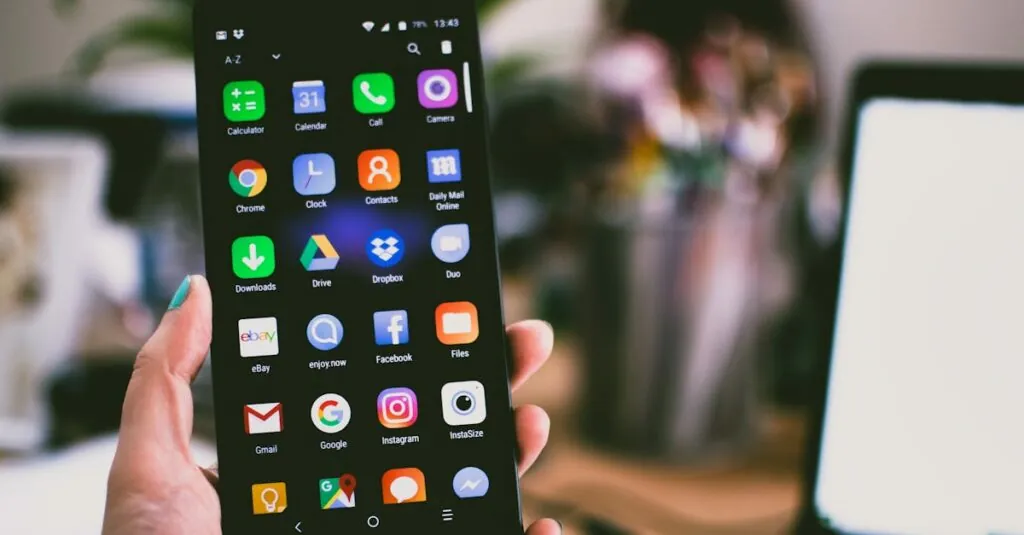In a world where smartphones have become an extension of ourselves, it’s hard to imagine life without that little pocket-sized miracle. From scrolling through social media to navigating the labyrinth of daily tasks, mobile phones have transformed how we connect, work, and even procrastinate. They’re not just gadgets; they’re our lifelines, our entertainment hubs, and sometimes, our best friends—minus the awkward silences.
But let’s face it—while these devices are incredibly handy, they can also be a source of endless frustration. Ever tried to find a charger when you’re down to 1% battery? Or accidentally sent a text to the wrong person? Yeah, we’ve all been there. Dive into the fascinating world of mobile phones, where convenience meets chaos, and discover why these devices are both a blessing and a hilarious curse.
Table of Contents
ToggleOverview of Mobile Phones
Mobile phones serve as vital instruments in today’s world, seamlessly integrating communication, work, and entertainment. Numerous features enhance user experience, including apps, internet access, and high-quality cameras. Users rely on these devices for quick communication, whether through calls, texts, or video chats.
Smartphones also function as portable entertainment hubs. They allow access to music, movies, and games, catering to diverse interests. Many people use mobile phones for social media engagement, sharing moments with friends and family. Additionally, navigation applications simplify travel by providing real-time directions.
Battery life remains a pivotal consideration for many users. Extensive use can drain batteries quickly, leading to frustration in essential moments. Furthermore, operating system updates often improve functionality and security, requiring attention to device management.
As technology advances, mobile phones evolve with features like artificial intelligence, enhancing personalization. Voice assistants facilitate hands-free operation, making daily tasks more efficient. Users often find convenience in app ecosystems that connect various services for improved productivity.
Look at market trends to gain insights into mobile phone capabilities. In 2023, over 1.3 billion smartphones were shipped globally, reflecting increased demand and innovation. Key manufacturers like Apple, Samsung, and Xiaomi lead the market, continually pushing boundaries in design and functionality. Consumers benefit from diverse choices that cater to budget, performance, and features, making mobile phones indispensable in daily life.
Evolution of Mobile Phone Technology
Mobile phone technology has transformed dramatically since its inception. The journey from bulky devices to sleek smartphones illustrates significant advancements.
Early Developments
The first mobile phones, introduced in the 1980s, were large and primarily focused on making calls. These devices relied on analog technology, which limited functionality. In 1992, the Motorola StarTAC emerged, revolutionizing portability with its flip design and compact size. These early developments paved the way for future innovations by introducing the concept of mobile communication to the masses.
Modern Advancements
Modern smartphones boast cutting-edge features that enhance user experience. With high-resolution cameras, users capture stunning photos effortlessly. Voice assistants like Siri and Google Assistant improve accessibility and efficiency. In 2023, advancements in 5G technology provide faster internet speeds, enabling seamless streaming and gaming. Major manufacturers like Apple and Samsung continuously push boundaries, integrating artificial intelligence for smarter devices. Enhanced battery technologies now support longer usage, addressing previous concerns. The evolution underscores the rapid pace of development in mobile phone technology, reflecting changing user needs and preferences.
Major Brands in the Mobile Phone Market
Key players in the mobile phone market drive innovation and shape consumer preferences. Major brands continuously adapt to meet demands for advanced technology and user convenience.
Apple
Apple holds a significant position in the smartphone market. The iPhone, Apple’s flagship product, features a user-friendly interface and strong security measures. High-quality cameras and regular software updates enhance the user experience, ensuring devices remain relevant over time. Apple’s ecosystem integrates seamlessly, allowing for smooth connections between devices. In 2023, Apple shipped approximately 225 million units worldwide, showcasing its enduring appeal and brand loyalty.
Samsung
Samsung ranks as a leading competitor in the mobile phone space. Renowned for its Galaxy series, Samsung delivers a diverse range of smartphones catering to various budgets and user needs. AMOLED displays and high-resolution cameras showcase the brand’s commitment to quality and innovation. Regular release cycles introduce cutting-edge features, such as advanced artificial intelligence functionalities. Samsung’s global smartphone shipments reached around 270 million units in 2023, demonstrating its widespread influence in the industry.
Other Notable Brands
Several other brands contribute to the dynamic mobile phone market. Xiaomi gains recognition for its affordable yet feature-rich smartphones, appealing to cost-conscious consumers. OnePlus also creates a niche with its flagship killer devices providing high performance at lower prices. Additionally, Google offers the Pixel series, famed for exceptional camera capabilities and seamless Android integration. In 2023, these brands collectively accounted for around 20% of the global smartphone market share, highlighting their growing importance and competition against established giants.
Key Features to Consider
Key features significantly impact the user experience and functionality of mobile phones. Understanding these aspects can enhance decision-making during device selection.
Camera Quality
Camera quality plays a pivotal role in modern smartphones. High-resolution sensors, such as those exceeding 108 megapixels, deliver stunning images. Advanced features, like optical image stabilization and night mode, enhance performance in varied lighting conditions. Manufacturers like Apple and Samsung equip their devices with multiple lenses, allowing for versatile photography options. Video recording capabilities also matter; many smartphones offer 4K resolution for sharp visuals. Users often prioritize devices that provide superior camera performance for both photos and videos.
Battery Life
Battery life remains a critical consideration for users. Many smartphones now boast batteries exceeding 4000 mAh, supporting hours of usage without charging. Devices with energy-efficient processors also enhance battery longevity. Quick charging capabilities offer convenience, with some models achieving 50% charge in under 30 minutes. Users increasingly seek devices that balance performance with extended battery life, making this feature essential. Evaluating how battery performance aligns with daily needs can guide smartphone choices effectively.
Operating System
Operating system choice significantly influences user experience. Android and iOS dominate the market, each offering unique features and interfaces. Android provides customization options, while iOS emphasizes seamless integration with other Apple products. Regular updates improve functionality and security across devices. Users benefit from a rich ecosystem of apps, although compatibility varies with different operating systems. Understanding how the operating system affects overall performance and user preferences aids in selecting the right smartphone.
Mobile phones have undeniably transformed daily life by blending convenience with complexity. They serve as vital communication tools while also providing entertainment and navigation solutions. As technology evolves, so do these devices, continually enhancing user experience through innovations in camera quality and artificial intelligence.
Despite the frustrations that can arise from battery life and software updates, the benefits far outweigh the drawbacks. The competitive landscape driven by major brands ensures ongoing advancements that cater to diverse user needs. Ultimately, smartphones remain integral to modern living, reflecting both the challenges and joys of a digital lifestyle.










